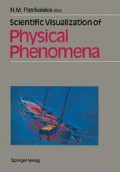Abstract
The trajectories of light rays are studied in media in which the refractive index varies with position. These are known as gradient index media, and the equation of motion of light rays through such media can be written in the same form as Newton’s law of motion for a particle moving in a conservative force field. We present ray traced images of two families of gradient index lenses: Luneberg Lenses and gradient index rod lenses. The equation of motion of light rays through the lenses are either solved exactly, or solved accurately by numerical means. Ray tracing is an important tool for visualizing the optical properties of such lenses and other gradient index media.
Access this chapter
Tax calculation will be finalised at checkout
Purchases are for personal use only
Preview
Unable to display preview. Download preview PDF.
References
Berger M, Trout T, Levit N (1990) Ray Tracing Mirages. IEEE Comp. Graph, and Appi., May, 1990 36–41
Born M, Wolf E (1980) Principles of Optics, 6th ed. Pergamon, Oxford, pp 101–132
Evans J (1990) Simple forms for equations of rays in gradient-index lenses. Am. J. Phys., 58: 773–778
Evans J, Rosenquist M (1985) F = ma optics. Am. J. Phys., 54: 876–883
Getto P H, Breen D (1990) An Object Oriented Architecture for Computer Animation System. Visual Computer 6: 79–92.
Halliday D, Resnick R (1978), Physics 4th ed., ( John Wiley & Sons, New York ), pp. 972–973.
Luneberg R P (1944) Mathematical Theory of Optics. Brown University mimeographed notes, University of California, Berkely, CA, 1964
Melles Griot (1988) Optics Guide 4, Melles Griot, Irvine, California
Misner C W, Thorne K S, Wheeler J A, Gravitation. Freeman, San Francisco Musgrave F K (1990) A Note on Ray Tracing Mirages. IEEE Comp. Graph, and Appl., November, 1990: 10–12
Press W H, Flannery B P, Teukolsky S A, Vettering W T (1988) Numerical Recipes in C: the art of scientific computation. Cambridge University Press, Cambridge
Walker J (1975) The Flying Circus of Physics With Answers. John Wiley & Sons, New York, p 120
Watt A (1989) Fundamentals of Three Dimensional Computer Graphics. Addison-Wesley, New York, pp 166
Author information
Authors and Affiliations
Editor information
Editors and Affiliations
Rights and permissions
Copyright information
© 1991 Springer-Verlag Tokyo
About this paper
Cite this paper
Suffern, K.G., Getto, P.H. (1991). Ray Tracing Gradient Index Lenses. In: Patrikalakis, N.M. (eds) Scientific Visualization of Physical Phenomena. Springer, Tokyo. https://doi.org/10.1007/978-4-431-68159-5_18
Download citation
DOI: https://doi.org/10.1007/978-4-431-68159-5_18
Publisher Name: Springer, Tokyo
Print ISBN: 978-4-431-68161-8
Online ISBN: 978-4-431-68159-5
eBook Packages: Springer Book Archive

